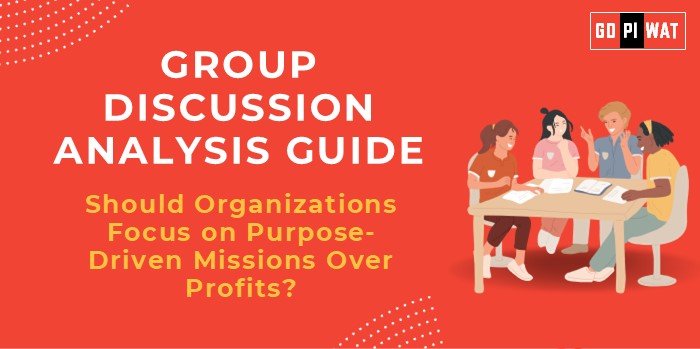📋 Group Discussion Analysis Guide
🌐 Should Organizations Focus on Purpose-Driven Missions Over Profits?
✨ Introduction to the Topic
Opening Context: Purpose-driven organizations aim to create long-term value by addressing societal or environmental issues, gaining momentum globally in the wake of rising ESG (Environmental, Social, and Governance) trends. This debate explores the balance between purpose and profit, which directly impacts corporate management strategies.
Topic Background: The concept of purpose-driven business gained traction post-2015 with the United Nations’ Sustainable Development Goals (SDGs), encouraging corporations to align business strategies with global well-being. Recently, companies like Patagonia, Toms, and Unilever have showcased the success of purpose-led strategies. However, skeptics question their financial sustainability in competitive markets.
📊 Quick Facts and Key Statistics
- ESG Assets: $40.5 trillion globally in 2023, expected to hit $50 trillion by 2025.
- Employee Preferences: 62% of millennials favor employers with strong societal missions (Deloitte, 2023).
- Profit Impact: Purpose-driven brands outperformed S&P 500 average by 206% from 2010-2020 (Porter Novelli Study).
- Consumer Behavior: 77% of consumers buy from brands with aligned values (Forbes, 2024).
🧩 Stakeholders and Their Roles
- Corporations: Balance purpose with profitability, integrating CSR and ESG initiatives into core operations.
- Investors: Push for measurable impact alongside returns, leveraging ESG reporting metrics.
- Employees: Seek organizations with meaningful missions for engagement and retention.
- Consumers: Reward purpose-driven brands through loyalty and advocacy.
- Governments/NGOs: Encourage ethical practices via regulations and partnerships.
🎯 Achievements and Challenges
🏆 Achievements
- Brand Loyalty: Toms Shoes reported a 35% loyalty boost due to its “One for One” model.
- Market Differentiation: Tesla’s focus on sustainability has made it a global leader in EVs, valued at $600 billion.
- Employee Retention: Unilever saw a 25% lower attrition rate for teams aligned with its purpose strategy.
- Innovation Catalyst: Purpose often drives innovation, as seen in IKEA’s climate-positive commitments by 2030.
⚠️ Challenges
- Profitability Trade-offs: Higher costs for sustainable materials or ethical practices can strain margins.
- Greenwashing Concerns: Misaligned claims can damage reputation (e.g., Volkswagen emissions scandal).
- Global Comparisons:
- Success: Denmark’s Lego transitioned to sustainable bricks, boosting both revenue and brand equity.
- Struggle: US coal companies faced backlash trying to rebrand as green energy providers.
📋 Case Study
Patagonia: The company’s “Earth is now our only shareholder” mission reduced profits short-term but enhanced long-term customer loyalty and environmental impact.
🛠️ Structured Arguments for Discussion
- Supporting Stance: “Purpose-driven missions strengthen long-term brand loyalty and stakeholder trust, enhancing organizational resilience.”
- Opposing Stance: “Overemphasis on purpose may compromise short-term profitability, making companies less competitive in volatile markets.”
- Balanced Perspective: “Purpose and profit must coexist—aligned strategies drive innovation while securing market leadership.”
📚 Effective Discussion Approaches
- Opening Approaches:
- Share a compelling statistic on ESG market growth.
- Use a real-life case study like Tesla or Patagonia.
- Frame the topic with a question about the feasibility of balancing purpose with profits.
- Counter-Argument Handling:
- Highlight cases like Tesla, showing profitability alongside purpose-driven missions.
- Acknowledge short-term trade-offs but focus on long-term value creation.
🔍 Strategic Analysis of Strengths and Weaknesses
- Strengths: Enhanced customer loyalty, innovation, long-term brand equity.
- Weaknesses: Potential short-term profit losses, risks of greenwashing.
- Opportunities: Growth in ESG investments, regulatory incentives.
- Threats: Market volatility, consumer skepticism.
🔗 Connecting with B-School Applications
- Real-World Applications:
- CSR initiatives, ESG-aligned supply chain models, and stakeholder value projects.
- Sample Interview Questions:
- “How do ESG factors influence corporate strategies?”
- “Can you suggest a balance between profitability and sustainability in corporate decision-making?”
- Insights for B-School Students:
- Leverage this topic in sustainability-focused case studies.
- Explore internships in ESG-compliant organizations.


